A research log by KATE BURNINGHAM, ABI BRAY, LUCY RICHARDSON, KATT SKIPPON and SUE VENN
The question of whether it is possible to live better by consuming less is a central one for CUSP. In order to answer this we need a rich understanding of the meanings that ‘stuff’ has in our lives. In this research log, Kate Burningham and colleagues offer insights into their analytical work in progress, summarising initial observations from a recent qualitative interview project with ten 18-22 year olds.
The question of whether it is possible to have more fun with less ‘stuff’ – to live better by consuming less – is a central one for CUSP. We can’t hope to answer this without a rich understanding of the meanings which the purchase and use of ‘stuff’ has in our lives. Understanding the consumption patterns of young people and exploring whether issues of sustainable consumption have any significance for them is especially important. Learning how and why they consume what they do on a daily basis, gives us insights into the potential, and challenges – for engaging them in moves towards more sustainable consumption.
Much research on young people’s consumption focuses on issues of style and their participation in spectacular subcultures. But most consumption is so everyday as to be almost invisible – what young people eat, wear or use on an ‘ordinary’ day has received less attention. We decided to focus on this and to explore in depth what 10 young people aged between 18-22 consumed on three ordinary days.
CUSP has partnered with Brand Legacy for this research, a marketing agency focusing on developing sustainable growth strategies for brands and businesses across the globe. Working together is rewarding and we are learning a lot from each other’s knowledge, skills and ways of working. Together we have developed an innovative methodology which produced in depth and authentic data about young people’s everyday consumption. Participants sent us photos via an instant messaging platform of all the things they ate on one day, wore on another and used for personal care on a third day. We then used these photos with them in an interview, discussing each item in turn, to explore how they acquired it, what was important to them about it and how it fits into their everyday routines.
Initial observations
Our initial observations on our interviews indicate several interesting avenues for further analysis:
Sociological theory tells us that consumption often involves processes of emulating the choices of more privileged members of society and also points to the way in which tastes work to distinguish sub groups from each other. We could see both of these forces at play in some of our interviewee’s discussions of clothing and personal care items. For instance one young woman kept and displayed packaging from expensive brands of cosmetics while one of the young men talked about how sharing tastes in clothing with his friends contributed to their sense of group identity. However, for many items our interviewees had little to say beyond the fact that their mother or grandmother had bought it for them. This reminds us that much consumption is not about displaying identity, and illustrates that it often happens within the context of family relationships. For both reasons we should be cautious about focusing too much on the idea of individual consumption choices.
The idea of health was frequently used to explain what was consumed, particularly in relation to food, but also with personal care items (looking for natural/unscented products), and clothes (with gym clothes or ‘athleisure’ being worn everyday by some). Most participants said that health was very important to them even if this was not reflected in their consumption. This focus on health exists in a context of health and fitness internet bloggers and vloggers who some of our respondents credited with influencing their choice of products.
Price was also very important in choosing what to buy or use as all of the young people interviewed were on relatively low, or no, income. However for some of the young women, personal care seemed to be an area in which they might splash out on expensive branded products which they viewed as better quality. This idea of spending one’s money wisely was a big theme in the conversations. This sometimes meant finding bargains and in other instances was about selecting brands which they thought performed well or would last.
We asked participants whether any sustainability issues influenced their everyday consumption – most weren’t instantly sure of the meaning of the word, but could offer up various definitions. A common focus was on the durability of products, and the idea of ‘getting your money’s worth’. Those who talked about the environment discussed recycling, which most respondents did as a habit passed down from parents. Food packaging was often discussed, with several suggesting that bigger, more noticeable re-cycling labels would help them to make more sustainable decisions. The importance of avoiding food waste was also frequently mentioned.
So, our initial observations illustrate how everyday consumption can be significant in terms of the construction of individual and group identity, and highlight the extent to which it is situated within relationships. Any promotion of ‘more fun with less stuff’ has to take these social functions of consumption very seriously. While the idea of sustainable consumption was not on our participants’ radar; discussion of health, durability and the avoidance of waste all resonated with them. Perhaps these are themes we should highlight as we seek to engage young people in discussions about sustainable prosperity.
Our next step involves looking at all of the interview data in much more detail and producing a report which we’ll share on the CUSP website. Look out for that!

